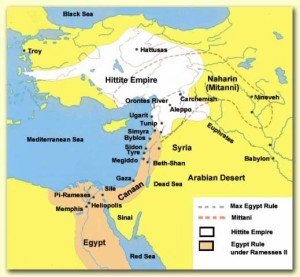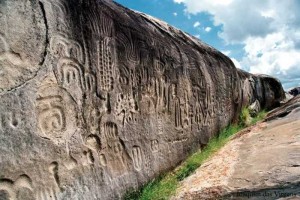Tudhaliya II
Hittites
The Hittites ruled an ancient kingdom, which, at its height controlled most of what is now the Asian part of Turkey. They flourished in the middle of the 2nd millennium BC. Despite the size of the Hittite Empire, there are relatively few surviving examples of Hittite art, so it was interesting to read in September 2021 that the oldest known example of Mediterranean mosaic was unearthed at Usakli Hoyuk, near Yozgat, in central Turkey. It is dated to the 15th century BC, 700 years before the earliest Greek example. “It is the ancestor of the classical period of mosaics that are obviously more sophisticated. This is a sort of a first attempt to do it,” says Anacleto D’Agostino, excavation director(f).
The Hittites were among a number of civilisations in the Eastern Mediterranean and Middle East at the end of the second millennium BC to collapse. In the case of the Hittites Sturt Manning has identified a severe multi-year drought that coincided with the Hittite collapse around 1198-1196 BC. Manning et al in a paper published in Nature in 2023 note that “the Hittite collapse forms part of a wider set of changes occurring across the Old World around 1200 BC. Climate alone was not the sole cause of these changes; very different histories are evident within the greater region”(f).
>In 2023, a reasonably intact inscribed tablet was discovered in the ruins of Büklükale which was formerly a major Hittite city. The 3,300-year-old tablet speaks of the catastrophic invasion of four Hittite cities while the Hittites themselves were in the middle of a civil war. “However, the invasion referenced by the newfound tablet doesn’t seem to be related to the Late Bronze Age collapse. Kimiyoshi Matsumura (its discoverer) said the tablet dates to the reign of the Hittite king Tudhaliya II, between about 1380 to 1370 B.C.- roughly 200 years too early” (h).<
Together with the ancient Egyptians, the Hittites are claimed by ‘rogue archaeologist’ David Hatcher Childress to have been the successors of Atlanteans. He  quotes their appearance, dress and construction techniques to support this contention. However, Childress’ views are very much at odds with the opinion of the professional archaeologist, Eberhard Zangger, who has identified some of the petty states to the west of the Hittite Empire as part of the alliance of Sea Peoples(d) and in that same region, Zangger equates Troy with Atlantis. rather than the enemies to the east.
quotes their appearance, dress and construction techniques to support this contention. However, Childress’ views are very much at odds with the opinion of the professional archaeologist, Eberhard Zangger, who has identified some of the petty states to the west of the Hittite Empire as part of the alliance of Sea Peoples(d) and in that same region, Zangger equates Troy with Atlantis. rather than the enemies to the east.
However, Iurii Mosenkis has published a short paper(e) in which he directly associates the Hittites with Atlantis and the Sea Peoples.
Childress describes them as great seafarers and he attributes to them the exploitation of the vast American copper reserves of North Michigan[620 ch.2].
The idea of Hittites in America is in no way new, as John Campbell (1840-1904) published a paper(b) with that very title in 1881, which is now available online.
The renowned, if controversial, epigrapher, Professor Barry Fell identified the writing on the Newberry Stone, found in 1896 in Michigan, as Hittite-Minoan. As there is no such language as Hittite-Minoan and the ancient exploitation of the Michigan copper mines by Old World traders is unproven(a), Childress’ claims are based on speculation and flimsy circumstantial evidence, which for me are far from convincing.
Even more exotic  was the claim by Gabriele Baraldi that the Hittites had developed an empire in Brazil, offering as evidence the petroglyphs on the Ingá Rock(c). Baraldi also located Atlantis in northeast Brazil.
was the claim by Gabriele Baraldi that the Hittites had developed an empire in Brazil, offering as evidence the petroglyphs on the Ingá Rock(c). Baraldi also located Atlantis in northeast Brazil.
(a) See Archive 2547
(b) https://openlibrary.org/books/OL24141925M/Hittites_in_America
(c) https://brazilweirdnews.blogspot.ie/2012/09/the-miystery-of-ingas-stone.html
(d) https://luwianstudies.org./
(e) https://www.academia.edu/38743064/The_Hittite_Empire_in_the_myth_of_the_Atlantis
